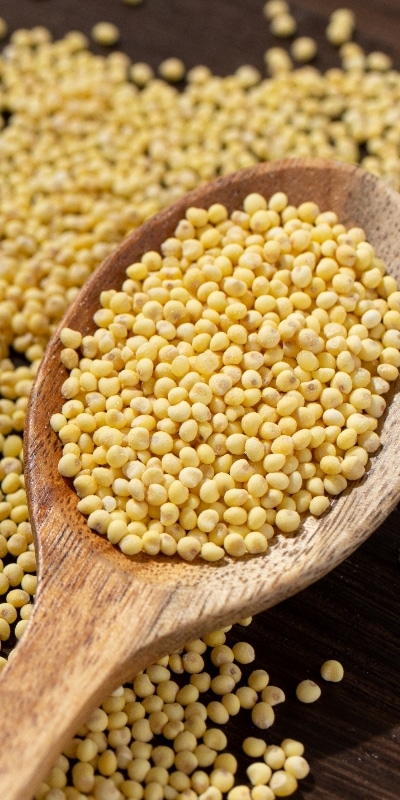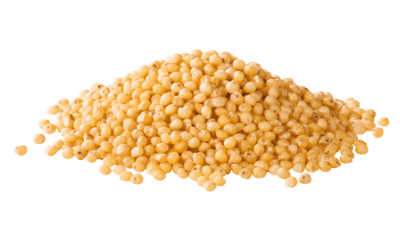
Health
benefits
Millet is a cereal that provides carbohydrates, fibre and many minerals and vitamins. Millet is :
- Rich in phosphorus | Phosphorus contributes to the maintenance of normal bones and teeth, as well as energy metabolism.
- Rich in copper | Copper is essential for maintaining a good energy metabolism, nervous system function and immune system.
- Rich in manganese | Manganese helps energy metabolism and bones and helps to protect cells against oxidative stress.
- Rich in selenium | Selenium is essential for the hair and nails, and for the immune system.
- A source of magnesium | Magnesium helps, among others, to reduce fatigue, keep our muscles working properly, and maintain normal energy metabolism and nervous system function.
- A source of zinc | Zinc intervenes in the cognitive function, carbohydrate metabolism and protein synthesis, and plays a role for fertility and reproduction, bones, hair, and skin.
- Rich in thiamine | Thiamine helps to maintain normal energy metabolism, psychological and heart function.
- Rich in niacin and source of biotin| Niacin and biotin are two vitamins that contributes, among other things, to a good working energy metabolism and psychological function.
*USDA Food Database
Nutritional
values
The right time
to eat it
Millet is available all year round.
Vegetable garden
or city balcony
In France, millet is mainly grown as bird seed. The seeds are sown in May and harvested in September or October. But the largest crops are grown in Asia and Africa. Millet can withstand very hot, dry and poor soils. Like all cereals, millet needs a lot of space, so it’s quite impossible to grow in your vegetable garden or city balcony…
Around four months are needed from sowing to harvesting. Long, thin green leaves develop first, then come the stalks and then the ears, a cluster of seeds that form a bunch on the stalk. They are a soft green, and the cluster is about 20cm long, changing colour when it ripens. Millet is harvested once the seeds are dry.
The seeds are small and round (just 2-3mm). They consist of a kernel, a germ and a hard husk. After harvesting, the millet is shelled in a mill and sold as millet grain, flakes or wholemeal flour (made from unhulled millet).
Choosing
and storing
To choose millet, simply opt for the form that matches your preparation. Millet grains, semolina and flakes can be stored at room temperature for about a month, away from light. To keep it for longer, simply refrigerate.
Tips
and tricks
Millet is eaten as a substitute for rice or potatoes, often simply cooked in water. In Africa, millet is widely eaten as a porridge or in patties. You can also cook it like a risotto: put the millet into an oiled pan, cover with stock and simmer until cooked.
Sweet millet? Yes, you can also find millet pudding, millet flake porridge and millet semolina cakes – great with raspberries or apricots.
Did you know? Millet is gluten-free! It’s ideal for people with coeliac disease (gluten intolerance).
What is the environmental
impact of millet?
We can find out more from its PEF (Product Environmental Footprint) score! This is a score established by Agribalyse*. It takes into account every stage in a vegetable’s life cycle: how it’s cultivated, the impact of processing and transport, etc. The lower the score, the less impact it has on the environment.
- Whole millet, raw: 0.14
- Raw beef steak: 2.77
*Figures drawn from the Agribalyse database, which calculates the environmental score of different types of food. This unique score is a weighted average of 16 indicators, calculated according to the European PEF methodology. It does not correspond to an environmental label or ‘eco-score’.
CO2 equivalent: for 100g of whole millet, raw: 0.087kg of CO2 eq, or as much as from 2.57g of raw beef steak.

Can everyone eat it?
Millet can be added to a baby’s diet just like other cereals. The texture of millet porridge is perfect for babies: it’s easy to eat and light in flavour.
Millet is not widely consumed in our part of the world, but interest is growing in this little cereal. With so many different ways to prepare it, with different textures and tastes, millet offers something for everyone. It’s cheap, nutritious, and easy to enjoy.
Where does it come from?
The origins and varieties of millet
Common millet is thought to have originated in China. It was domesticated a very long time ago, even before wheat. There are several varieties of common millet. The most widespread is common white millet. The sub-family includes fonio, teff and proso millet.



 Borlotti beans
Borlotti beans  Lentils
Lentils  Vegetable garden: growing avocado
Vegetable garden: growing avocado 









